Carvers make a beeline for this tree
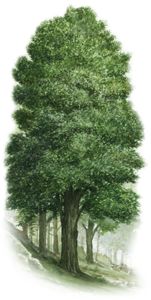
Among the most important of America’s nectar-producing trees, the basswood makes itself at home along city streets as well as in the forest. In cityscapes, nurserymen call the hardy, decorative tree American linden. But in the woods, it’s basswood, beetree, lime, or whitewood. Regardless of its name, basswood has proven its value.
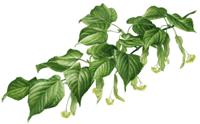
Indians of New York state’s Iroquois nation carved ceremonial masks from the sapwood of living basswood trees, then split the green-wood masks from the trunk. The gummy inner bark provided bandages. And from its dried fibers they wove rope.
Beekeepers even today appreciate the quality of basswood-derived honey. In summer, the tree’s fragrant flower clusters provide a strong-flavored nectar. Basswood stock also becomes the very boxes in which the honeycombs are stored and shipped.
Wood identification
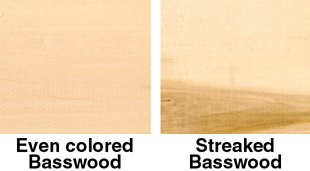
The forest-products industry lumps the four native North American basswood species together in the marketplace, for there are few differences between them, except where they grow. Tilia americana, of the northern Great Lakes states, provides most of the basswood harvested.
In a setting of mixed hardwoods in the well-drained ground of a stream valley, basswood can grow to 90′ tall with a straight trunk 3′ in diameter. But because basswood sprouts from the stump, it’s often seen as a clump of three or four smaller trunks.
Young basswood trees feature light gray, smooth bark, while that of older trees becomes darker and deeply ridged. In late winter, small reddish-brown buds appear on branch twigs. Their nutlike flavor signals that you’ve found a basswood tree.
When leaves form, they have a distinctive heart shape with lightly serrated edges. The leaves also display an unusual trait: The undersides, not the tops, are shiny. Clusters of sweet-smelling white or cream-colored flowers follow the leaves.
Weighing about 26 pounds per cubic foot air-dried, the wood has a tan color, and in some cases may be nearly white. You’ll find the grain of this soft hardwood straight, close, and normally featureless. Occasional basswood stock may display some dark stain, which doesn’t affect the wood’s performance but may mar a project. Dry basswood is stable.
Uses in woodworking
Carvers prefer basswood because it holds detail well, doesn’t split, has straight-grain, and carves easily. They usually prefer air-dried, slow-grown northern stock.
Basswood also can become drawer stock, hidden furniture parts, and painted items. In industry, it plays a role as boxes and food containers. As veneer, it can underlie fine cabinet woods in plywood. This light, versatile wood also works for picture frames, toys, and millwork such as window sashes. It even makes fine turning wood.
AvailabiIity
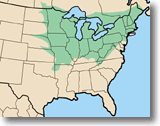
Many large hardwood retailers outside its natural range carry basswood in board form. Specialty suppliers offer basswood carving blocks and blanks.
Veneer isn’t available at retail.
Both northern and southern varieties of basswood show little contrast between early wood and late wood, although northern basswood provides tighter-grained, finer-textured stock. Carvers also will want to avoid basswood with mineral stains, unless the project will be painted.
If you’re a carver who likes to gather stock yourself—and live where basswood grows—try this method to dry your wood. Harley Refsal, WOOD® magazine’s carving consultant, dries his northern- Iowa basswood this way: He cuts 18″ lengths from a log or large branch, then halves and quarters them with an ax. Next, he removes the pith (inner core of the heartwood) and wraps each quarter completely with two layers of newspaper. Harley fastens the wrapped stock between the floor joists in his basement furnace room and leaves them to air dry for six to eight weeks. In the summertime, he dries the wood overhead in the garage.
Not a carver? You still may want to try this easily worked wood. Here’s some guidance:
Machining methods
- Basswood’s low-hardness rating makes it ideal for hand tools.
- Power planing basswood poses no problems. You’ll find jointing effortless, too.
- Because the wood is dense, ripping requires a rip-set blade with 24 teeth or less to avoid burning. In crosscutting, it won’t tear out or chip.
- Use sharp bits and don’t rush the router when shaping basswood, as its tight grain and density does tend to burn (although burns easily sand off).
- Unlike some other lightweight, straight-grained woods (such as redwood), basswood fastens well with nails or screws. And it’s not necessary to predrill.
- Sanding basswood proves to be a soothing, smoothing task. But when it comes to staining, blotching can result. If uneven staining appears on a test piece, apply wood conditioner before staining. Remember, though, even wood conditioner won’t subdue discolored streaks in the wood.
Carving comments
It would be hard to find a wood more perfect for carving. A sharp knife or gouge slides through it as if cutting butter. And the finish of a clean cut looks lustrous.
- Because basswood takes fine detail, it’s great for relief, figure, and chip carving.
- Basswood requires control or your carving tool may go further along a stroke than planned.
- Strengthen details subject to breakage with a thinned coat of woodworker’s glue (it won’t take stain) worked into the wood.
Turning tips
Woodturners will find basswood superb for food containers, since it imparts no odor or taste.
SHOP-TESTED TECHNIQUES THAT ALWAYS WORK
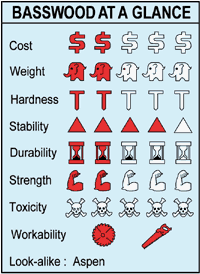
Any exceptions—and special tips pertaining to this issue’s featured wood species—appear under other headings on this page.
- For stability in use, always work wood with a maximum moisture content of 8 percent.
- Feed straight-grained wood into planer knives at a 90° angle. To avoid tearing, feed figured wood or twisted grain at a slight angle (about 15°), and take shallow cuts of about 1/32″.
- For clean cuts, rip with a rip-profile blade that has 24-32 teeth. Smooth crosscutting requires at least a 40-tooth blade.
- Avoid using twist drills. They tend to wander and cause breakout. Use brad-point bits and a backing board under the workpiece to reduce tearout.
- Drill pilot holes for screws.
- Rout with sharp, preferably carbide-tipped, bits and take shallow passes to avoid burning.
- Carving softwoods, and a soft hardwood like basswood, means fairly steep gouge bevels—greater than 20°.

